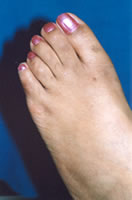The photographs below are of the left foot before and after a bunionectomy.
| Before Bunionectomy | Five (5) days after Bunionectomy | Four (4) weeks after Bunionectomy | Slideshow | |
|---|---|---|---|---|
 |
 |
 |
 |




|
Bunions / Bunionectomy
A bunion is a deformity that usually occurs at the head of the first of five long bones (the metatarsal bones) that extend from the arch and connect to the toes.
The first metatarsal bone is the one that attaches to the big toe. The big toe is forced in toward the rest of the toes, causing the head of the first metatarsal bone to jut out and rub against the side of the shoe; the underlying tissue becomes inflamed and a painful bump forms.
As this bony growth develops, the bunion is formed as the big toe is forced to grow at an increasing angle towards the rest of the toes.
A bunion may also develop in the bone that joins the little toe to the foot (the fifth metatarsal bone), in which case it is known as a bunionette or tailor's bunion.
Bunions often develop from wearing narrow, high-heeled shoes with pointed toes, which puts enormous pressure on the front of the foot and causes the foot and toes to rest at unnatural angles.
Injury in the joint may also cause a bunion to develop over time. Genetics play a factor in 10% to 15% of all bunion problems; one inherited deformity, hallux valgus, causes the bone and joint of the big toe to shift and grow inward, so that the second toe crosses over it. Flat feet, gout, and arthritis increase the risk for bunions.
Bunion FAQs
What is a Bunion?
A bunion is a bulge on the inside of the foot at the base of the big toe joint. It forms when the bone at the big toe joint moves out of place, forcing the big toe to move towards the smaller ones. A Bunionette or Tailor's Bunion is another type of bunion that occurs on the outside of the foot at the base of the little toe. Common symptoms associated with a bunion are swelling, redness, corns, overlapping toes, restrictive motion, and pain.
What causes Bunions?
Most commonly experienced by women, bunions are bought about by years of abnormal foot function and pressure over the joint. Certain foot types (i.e. flat feet) are more prone to bunions, as well as foot injuries, the way we walk, and the shoes we wear. Many women wear dress shoes that are too small and narrow for their foot type. This causes the foot to take on the shape of the shoes, and forces the metatarsophalangeal (MTP) joint to stick out on the side of the foot.
A bunion happens when the long bone behind your big toe, first metatarsal, begins to shift away from the foot and the big toe begins to move toward the other toes. Genetics play a role in the development of bunions. Many people do not have discomfort until they are in improperly fitting shoes. Although it may seem that the shoe caused the bunion problem, an individual is usually predisposed to this condition by hereditary factors or abnormal foot function. Over time, bunions tend to get worse.
A Tailor's bunion, also sometimes referred as a bunionette, is very similar to a bunion. While the bunion is located relative to the big toe, the bunionette affects the long bone behind the little toe.
What treatments are available?
For relief of pain caused by a bunion, the following treatments are usually recommended:
- Wear shoes that fit properly
- Apply ice packs daily to reduce swelling
- Soak your feet in warm water
- Use non-medicated foot products such as bunion pads, night splints, shields, and bandages
- Ultrasound therapy
- Cortisone injections
- Orthotics
- A bunionectomy may be necessary in severe cases
Treatment for bunion pains should be discussed with your podiatrist. Many times, conservative measures include changing to wider shoes, orthotics, or paddings to relieve the pressure. Your podiatrist can also discuss surgical options in many instances to correct the bunion deformity.
Treatment should be based on relief of pain and a quick return to your activities of daily living. In the evaluation of your bunion, your podiatrist will evaluate the big toe joint and x-rays to examine the bones associated with the area.
The purpose of this article is to educate and not replace the advise of a medical professional. If you should have any questions, please seek the assistance of a podiatrist or other health professional that will be able to further the discussion and recommend appropriate interventions.
If you are experiencing any of the symptoms addressed, we strongly recommend that you seek the advice of your podiatrist for proper diagnosis.